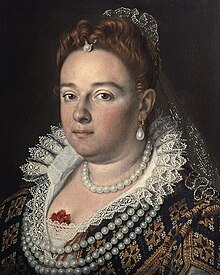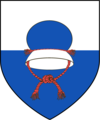Bianca Cappello
| Bianca Cappello | |||||
|---|---|---|---|---|---|
 Bianca Cappello by Scipione Pulzone | |||||
| Grand Duchess consort of Tuscany | |||||
| Tenure | 12 June 1579 – 20 October 1587 | ||||
| Coronation | 12 June 1579 | ||||
| Born | 1548 Venice, Republic of Venice | ||||
| Died | 20 October 1587 (aged 38–39) Poggio a Caiano, Tuscany | ||||
| Spouse |
[1] | ||||
| Issue | Virginia Pellegrina Bonaventuri Antonio de' Medici | ||||
| |||||
| House | Cappello Medici | ||||
| Father | Bartolomeo Cappello | ||||
| Mother | Pellegrina Morosini | ||||
Bianca Cappello (1548 – 20 October 1587) was an Italian noblewoman, the Grand Duchess consort of Tuscany by marriage to Francesco I de' Medici, Grand Duke of Tuscany. She was Francesco's mistress that later married him to became his consort. Coincidentally, the creation of the fortunate term serendipity by the writer Horace Walpole is due to a portrait of Bianca.
Early life
[edit]
Bianca was born in Venice, in 1548, as the second child and only daughter of Venetian nobleman Bartolomeo Cappello (1519-1594) and his wife, Pellegrina Morosini, a member of the Morosini family, one of the richest, noblest and most powerful Venetian noble families, and was noted for her great beauty.[2] She had an older brother, Vittorio Cappello (b. 1547), who served as Prime Minister of Tuscany (1579-1581).[3]
First marriage
[edit]At the age of fifteen she fell in love with Pietro Bonaventuri, a young Florentine clerk in the firm of Salviati family, and on 28 November 1563 escaped with him to Florence, where they were married. In 1564 she had a daughter named Virginia, or, according to other sources, Pellegrina. The Venetian government made every effort to have Bianca arrested and brought back but the Grand Duke Cosimo I intervened in her favour and she was left unmolested.[4][5]
However, she did not get on well with her husband's family, who, although noble, were very much impoverished and made her do menial work, until at last her beauty attracted Grand Prince Francesco, son and heir apparent of the grand duke.[6]
Mistress of Francesco
[edit]Although already married to Joanna of Austria, Francesco seduced Bianca and gave her jewels, money and other presents. Bonaventuri, Bianca's husband, was given court employment and consoled himself with other ladies until, in 1572, he was murdered in the streets of Florence in consequence of some amorous intrigue. It is possible that Bianca and Francesco were involved.[4]
On the death of Cosimo in 1574 Francesco succeeded to the grand duchy; he now installed Bianca in a palace (now known as Palazzo di Bianca Cappello) close to his own and outraged his wife by flaunting his mistress before her. At this point, Francesco had no legitimate son to inherit the duchy; a child by Bianca, though illegitimate, would be a potential heir, and by extension would secure Bianca's own position.[4] In 1576 she duly gave birth to Don Antonio de' Medici (d. 1621), but his father, still hoping to have a legitimate son by his wife, refused to acknowledge him. Francesco and Joanna then produced a son, Grand Prince Philip de' Medici, in 1577; the child survived the perilous months of early infancy, and Bianca's hopes of being anything more than a favoured mistress seemed dashed.[7]

Grand Duchess consort of Tuscany
[edit]
In 1578, Joanna died; a few months later Francesco secretly married Bianca, and on 10 June 1579, the marriage was publicly announced, and Antonio acknowledged as the Duke's son. Two days later, on 12 June, Bianca was crowned the Grand Duchess of Tuscany at the Palazzo Vecchio in Florence. The Venetian government now put aside its resentment and was officially represented at the magnificent wedding festivities, for it saw in Bianca Cappello an instrument for cementing good relations with Tuscany.
Bianca's position, however, was still not secure. The heir remained the young Grand Prince Philip; her own son by Francesco, though acknowledged, remained illegitimate, barred from inheriting the duchy. There would be no more children born of the relationship, and Bianca was aware that, if her husband were to die before her, she was lost, for his family, especially his brother Cardinal Ferdinand, hated her bitterly, as an adventuress and interloper.[4][8]
In 1582, however, Grand Prince Philip died. Francesco immediately began working on securing the succession for his remaining son, Antonio, having him legitimated and declared heir apparent, with the support of Philip II of Spain. As the mother of the heir, Bianca's position was far stronger: even if Francesco died before Antonio reached adulthood, Bianca would have a good claim to ruling as regent on her son's behalf, and her husband's family would give her more respect as the mother of the heir.
In October 1587, at the Villa Medici in Poggio a Caiano, Francesco and Bianca died on 19 and 20 October, possibly poisoned, or as some historians believe, from malarial fever. As Bianca wasn't an official member of the Medici family, Cardinal Ferdinand did not allow her to be buried in the Medici family tombs.[9] Instead, some believe that Bianca was buried in an unmarked mass grave under the church of St. Lorenzo, having been brought back to Florence from Poggio a Caiano. In 2006, forensic and toxicology experts at the University of Florence reported evidence of arsenic poisoning in a study published in the British Medical Journal,[10] but in 2010 evidence of the parasite Plasmodium falciparum, which causes malaria, was found in Francesco's remains.[11]
Legacy
[edit]A modified version of the story of Bianca Cappello served as the basis of the theatrical tragedy Women Beware Women by Thomas Middleton, which debuted circa 1621, thirty-four years after the death of Bianca Cappello (whose name Middleton rendered as Bianca Capella). Bianca Cappello has since had occasional literary incarnations, serving as the focal character of the novels Bianca Cappello: an historical romance (1843) by Rosina Bulwer Lytton, Bianca Cappello: a tragedy (1873) by Elizabeth C. Kinney, and Bianca (1992) by Robert Elegant. Bianca Cappello, portrayed by Margaret Rawlings, was also the focal character of the Clifford Bax play The Venetian which in 1931 debuted on the West End stage and - subsequent to a tryout engagement in Chicago - made a short-lived transfer to Broadway.
References
[edit]- ^ Bianca died a day after Francesco.
- ^ Lytton, Lytton, Rosina Wheeler Bulwer (2010). Bianca Cappello: An historical romance. Nabu Press. pp. 13–14. ISBN 978-1144883667.
- ^ https://libsvcs-1.its.yale.edu/walpoleimages/hwcorrespondence/24/028.pdf [bare URL PDF]
- ^ a b c d One or more of the preceding sentences incorporates text from a publication now in the public domain: Villari, Luigi (1911). "Cappello, Bianca". In Chisholm, Hugh (ed.). Encyclopædia Britannica. Vol. 5 (11th ed.). Cambridge University Press. pp. 288–289. The above cites:
- S. Romanin, Lezioni di storia Veneta, vol. ii. (Florence, 1875)
- G. E. Saltini, Tragedie Medicee domestiche (Florence, 1898)
- ^ Sizeranne, Robert de La (1969). Celebrities of the Italian Renaissance in Florence and in the Louvre. Bianca Cappello in the Pitti Palace. pp. 122–124. ISBN 978-0836913026.
{{cite book}}: CS1 maint: location missing publisher (link) - ^ Sizeranne, Robert de La (1969). Celebrities of the Italian Renaissance in Florence and in the Louvre. Bianca Cappello in the Pitti Palace. pp. 125–126. ISBN 978-0836913026.
{{cite book}}: CS1 maint: location missing publisher (link) - ^ Roberto Cantagalli, "Bianca Cappello e una leggenda da sfatare; La questione del figlio supposto," Nuova rivista storica 44 (1965): 636–652; Jacqueline Marie Musacchio, "Objects and Identity: Antonio de' Medici and the Casino at San Marco in Florence,” in The Renaissance World, ed. John Jeffries Martin (New York: Routledge, 2007), 481–500.
- ^ Sizeranne, Robert de La (1969). Celebrities of the Italian Renaissance in Florence and in the Louvre. Bianca Cappello in the Pitti Palace. pp. 129–130. ISBN 978-0836913026.
{{cite book}}: CS1 maint: location missing publisher (link) - ^ Hayes, Mary (1803). Female Biography; or, Memoirs of Illustrious and Celebrated Women, of All Ages and Countries (1 ed.). London: Chawton House Library Series: Women’s Memoirs. pp. 419–422.
- ^ Francesco Mari; Aldo Polettini; Donatella Lippi; Elisabetta Bertol (2006). "The mysterious death of Francesco I de' Medici and Bianca Cappello: an arsenic murder?". BMJ. 333 (23–30 June 2006): 1299–1301. doi:10.1136/bmj.38996.682234.AE. PMC 1761188. PMID 17185715.
- ^ Lorenzi, Rossella (14 July 2010). "Medici family cold case finally solved". Discovery.com. Retrieved 16 July 2012.
Sources
[edit]- James Chater, "Bianca Cappello and Music", in Renaissance Studies in Honor of Craig Hugh Smyth (Florence, 1985), vol. i, 569–79
- Samuele Romanin, Lezioni di storia Veneta, vol. ii (Florence, 1875)
- G. E. Saltini, Tragedie Medicee domestiche (Florence, 1898)
- Saltini, Della morte di Francesco de' Medici e di Bianca Cappello (Florence, 1863)
- Elizabeth Clementine Stedman, Bianca Capello, A Tragedy (1873)
- Steegman, Bianca Cappello (Baltimore, 1913)
- This article incorporates text from a publication now in the public domain: Gilman, D. C.; Peck, H. T.; Colby, F. M., eds. (1905). New International Encyclopedia (1st ed.). New York: Dodd, Mead.
{{cite encyclopedia}}: Missing or empty|title=(help) - Rosina Wheeler Bulwer-Lytton Lytton (2010) Bianca Cappello: An Historical Romance Nabu Press ISBN 978-1144883667
Further reading
[edit]Bax, Clifford, Bianca Cappello (London, 1927): a modern biography
